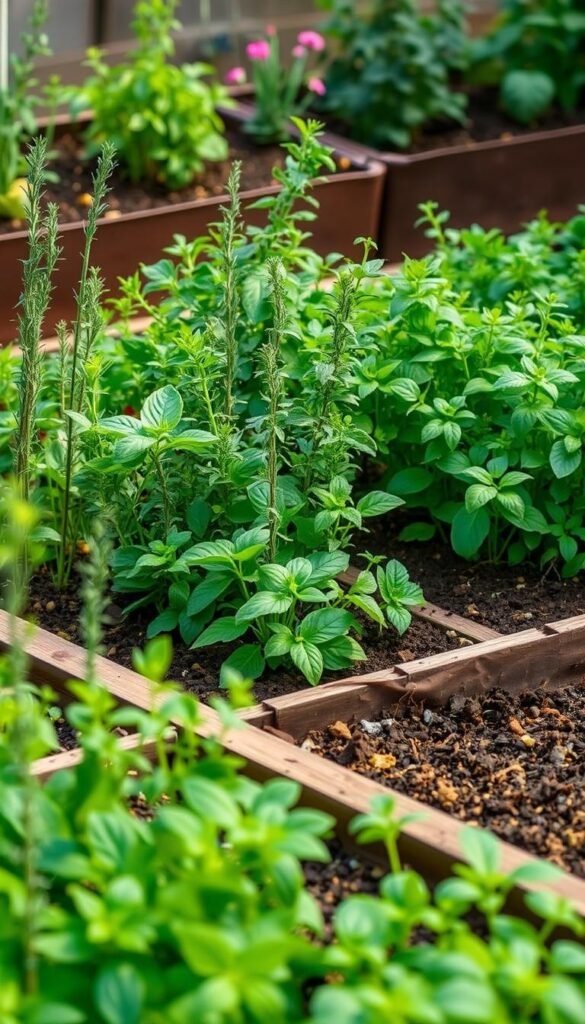Want fresh flavors at your fingertips? Whether you’re working with a backyard plot or small-space gardening setups, cultivating aromatic greens can transform your meals and outdoor areas. This guide focuses on easy-to-grow varieties that flourish in cooler and warmer climates, perfect for organized planting systems.
You’ll discover resilient options like basil, thyme, and mint – all known for thriving in tight quarters. These selections work well alongside vegetables like tomatoes, creating natural pest control while maximizing yields. Even better, many require just 6 hours of sunlight and adapt to container growth.
We’ve combined expert cultivation advice with practical design ideas to help you succeed. Learn about companion pairings that boost growth, plus tips for using self-watering containers and proper drainage. From medicinal teas to kitchen staples, every suggestion comes from trusted horticultural sources to ensure your green space stays vibrant year-round.
Ready to elevate your outdoor experience? Let’s explore how simple adjustments can lead to bountiful harvests, even in limited areas. Your journey to a more flavorful life starts here.
Introduction to Square Foot Herb Gardening in Zones 6 and 9
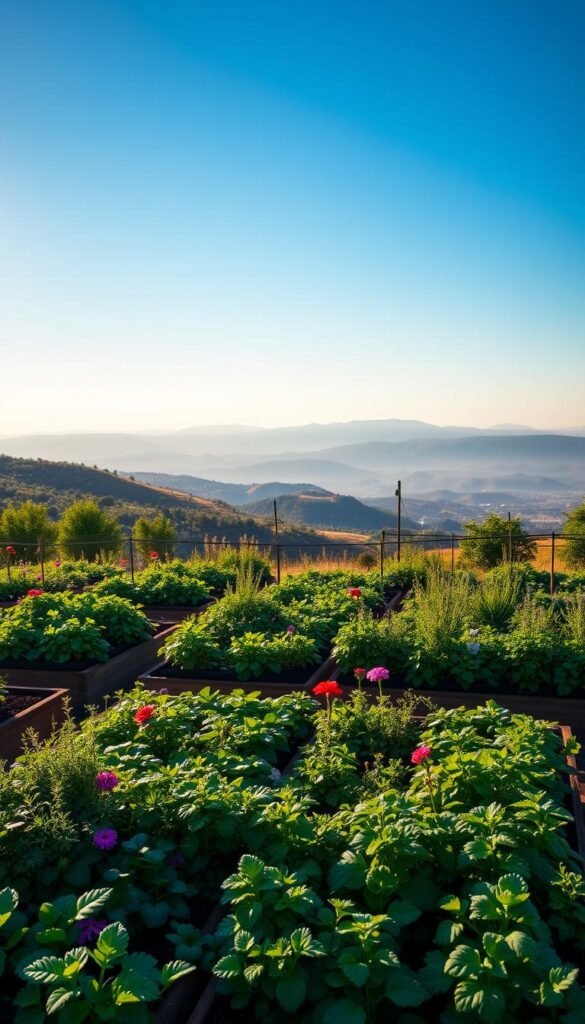
Imagine stepping outside to snip fresh herbs for tonight’s dinner, even if your growing space is small. Square foot gardening simplifies this dream by dividing beds into 1×1-foot sections, letting you grow more in less room. This method shines in Zones 6 and 9, where weather shifts demand adaptable planting strategies.
Compact layouts let you mix herbs like parsley and chives without crowding. Many thrive with minimal water and partial shade, making them easy to grow even for beginners. You’ll enjoy fresh flavors year-round, whether adding basil to summer salads or rosemary to winter stews.
Benefits of Compact Gardening for Your Herbs
This approach saves space while boosting yields. For example, you can plant 16 herbs in a 4×4-foot bed. The tight spacing reduces weeds, and grouped plants create natural shade to protect roots during hot days.
| Feature | Traditional Gardening | Square Foot Method |
|---|---|---|
| Space Used | Wide rows | Concentrated grids |
| Maintenance | Frequent weeding | Minimal upkeep |
| Harvest Time | Seasonal peaks | Continuous picking |
| Adaptability | Fixed layouts | Adjusts to weather |
Focus on soil quality and drainage to keep plants healthy. Rotate herbs each season to prevent nutrient depletion. Later, we’ll explore which varieties work best for your climate and cooking style.
Top Herbs for Zone 6 and Zone 9 Square Foot Gardens
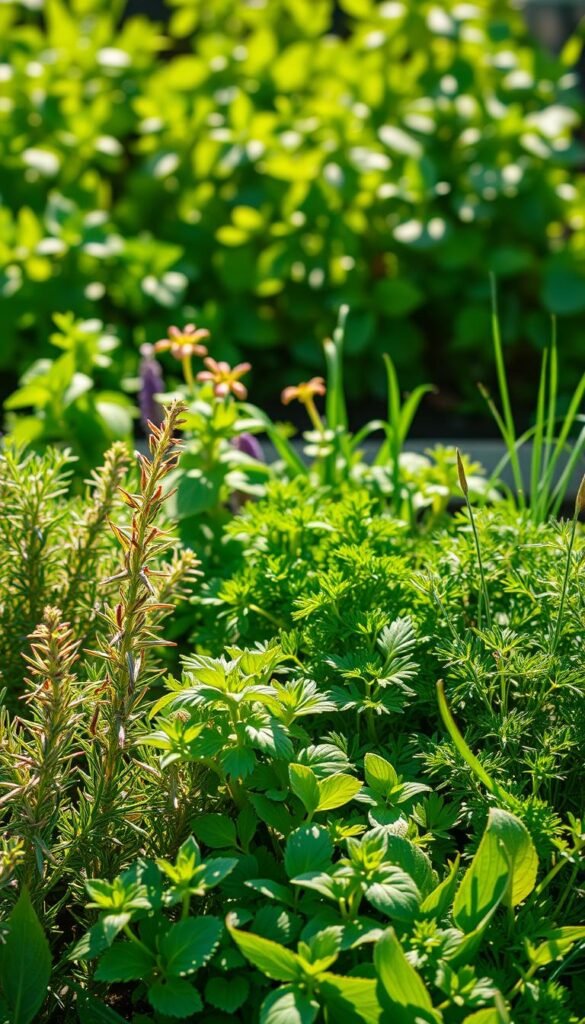
Transform your cooking and wellness routines with herbs that pull double duty. These aromatic plants pack intense flavors while offering natural health benefits, all while fitting perfectly into structured growing spaces. Let’s explore varieties that excel in both cooler and warmer climates.
Must-Grow Varieties and Their Superpowers
- Cilantro thrives in spring and fall’s 50-70°F range. Its lacy leaves enhance salsas and detox teas. Plant near tomatoes using this spacing guide to prevent overcrowding.
- Dill needs early sowing before temperatures hit 75°F. Its feathery fronds flavor pickles while attracting beneficial insects. One plant per square keeps roots happy.
- Parsley handles partial shade, making it ideal for garden edges. Rich in vitamins, it’s a garnish hero that repels carrot flies when paired with root vegetables.
Mint varieties like peppermint flourish in moist zones but require containers to control spreading. Oregano becomes drought-tolerant once established, perfect for sunny corners. Both make soothing teas for digestion support.
Chives and thyme excel in tight spaces. Their compact growth allows 4-6 plants per square. Snip chives for potato dishes or thyme for roasted meats. These perennials return yearly with minimal care.
For continuous harvests, keep lemon balm in afternoon shade. Its citrusy leaves calm nerves in teas while deterring mosquitoes. Rotate these herbs annually to maintain soil vitality across seasons.
Growing Tips for Easy Herb Cultivation
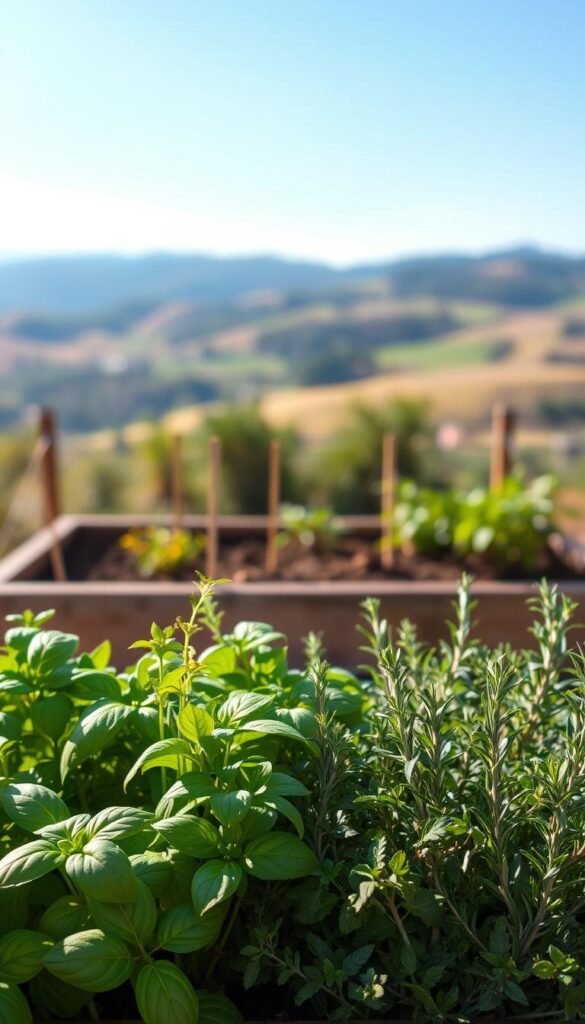
Nurturing herbs becomes effortless when you align their needs with simple care routines. Let’s break down the essentials to keep your green allies thriving without guesswork.
Sunlight, Water, and Soil: Essentials for Growth
Most herbs demand 4-6 hours of sunlight daily. Position pots near south-facing windows or garden spots with morning sun. Check soil moisture by sticking your finger an inch deep – water only when dry to prevent root rot.
Choose containers with drainage holes and use well-aerated potting mix. For seeds, plant them twice as deep as their size and keep the soil moist until sprouts appear. This easy grow strategy works for basil, oregano, and other kitchen staples.
Harvesting Strategies for Continuous Freshness
Snip leaves regularly to encourage bushier growth. Always cut above leaf nodes using clean scissors. For woody herbs like rosemary, trim stems by one-third during cooler temps to avoid stressing the plant.
Rotate pots weekly for even sun exposure. If frost threatens, move containers indoors overnight. Pair these habits with monthly compost tea feedings, and you’ll enjoy fresh flavors from seedling to harvest.
Selecting Herbs Suited to Your Climate
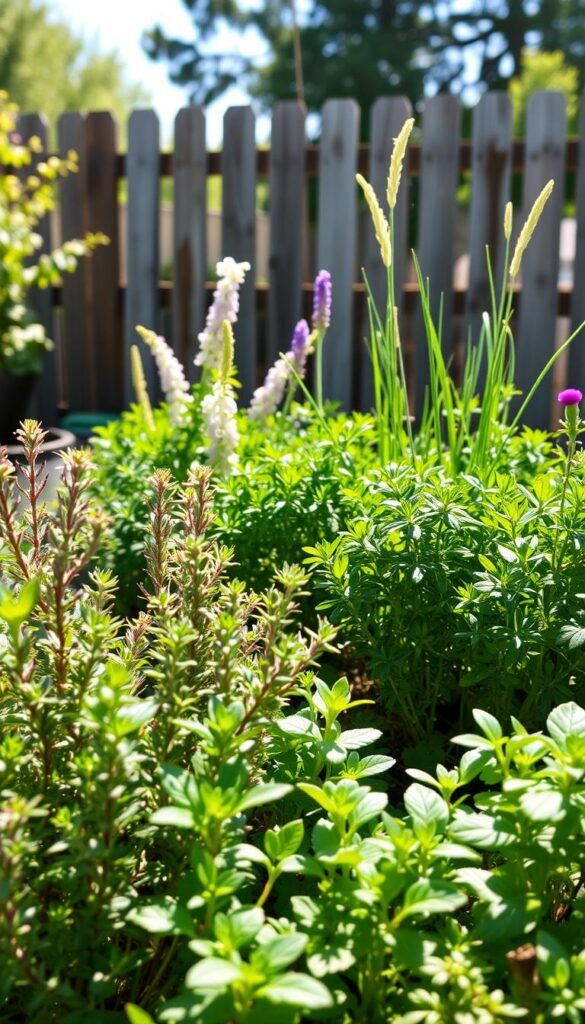
Your herb garden’s success starts with choosing plants that love your local weather. Cold snaps in Zone 6 and intense summer heat in Zone 9 require smart picks. Focus on hardiness ratings to ensure your green friends survive – or thrive – through seasonal shifts.
Winter Warriors and Seasonal Stars
Hardy perennials like thyme and sage laugh at frost, coming back year after year. Tender herbs like basil? Treat them as annuals or move pots indoors when temps drop below 40°F. Check plant tags for USDA zone numbers – your roadmap to year-round growth.
- Survivors (Zone 6): Rosemary (with protection), chives, oregano
- Summer Lovers (Zone 9): Cilantro, parsley, lemon verbena
Raised beds boost drainage during wet winters, while containers let you shuffle sun-sensitive plants. Mulch roots with straw when frost threatens – your secret weapon against freeze damage.
| Herb Type | Zone 6 Strategy | Zone 9 Solution |
|---|---|---|
| Hardy (e.g., sage) | Leave in ground | Partial afternoon shade |
| Tender (e.g., basil) | Grow as annual | Summer harvests only |
Notice sunny vs. shady spots in your garden. South-facing raised beds warm faster in spring, perfect for early parsley. Share your space wisely – let hardy herbs anchor beds while seasonal stars rotate through containers. Your family’s meals will thank you!
Culinary and Medicinal Benefits of Herbs
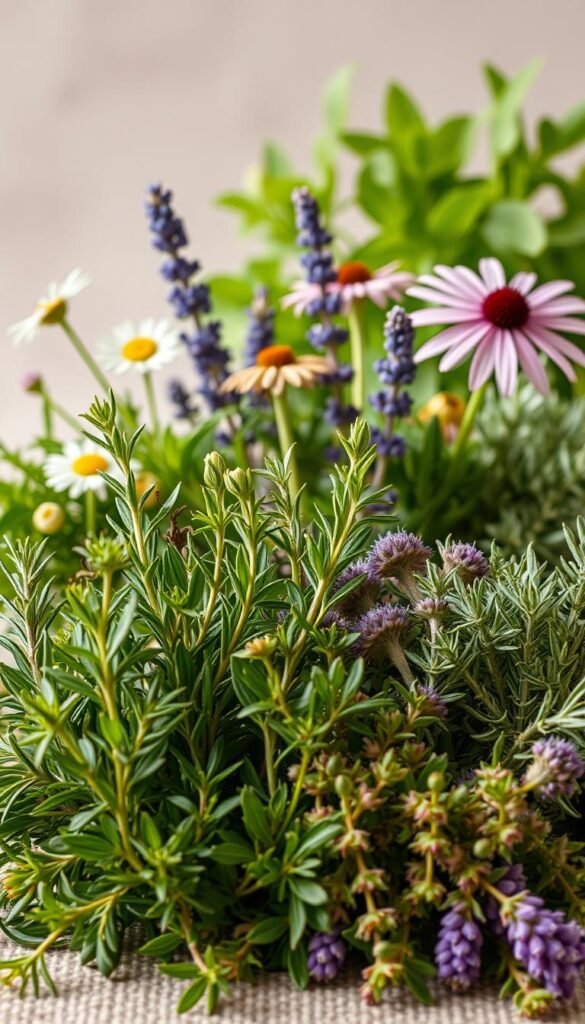
Elevate your meals and wellness rituals with homegrown herbs that do more than just taste great. These fragrant plants let you skip pricey spice aisles while adding vibrant, fresh flavors to every dish. Better yet, many double as natural remedies for common ailments.
Enhancing Your Recipes with Fresh Flavors
Snip fresh leaves straight into soups, salads, or marinades. Basil’s peppery notes elevate pasta, while chives (a mild onion relative) add zing to baked potatoes. You’ll notice richer flavors compared to dried grocery store herbs, and a single plant can yield multiple harvests.
Try these simple swaps:
- Use chopped parsley instead of salt for savory depth
- Infuse olive oil with rosemary for bread dipping
- Freeze mint in ice cubes for summer drinks
Natural Remedies for Everyday Wellness
Many best herbs to grow offer healing properties. Lemon balm’s citrusy leaves calm stress when brewed into tea, while chamomile flowers ease digestion. Keep a windowsill planter with these multitaskers:
- Peppermint: Soothes headaches
- Thyme: Fights coughs
- Lavender: Promotes sleep
Harvesting often keeps plants bushy and productive. Dry extra leaves for homemade spice blends or aromatic sachets. Why buy tea bags when your garden provides fresher, chemical-free options?
Designing Your Square Foot Garden Layout
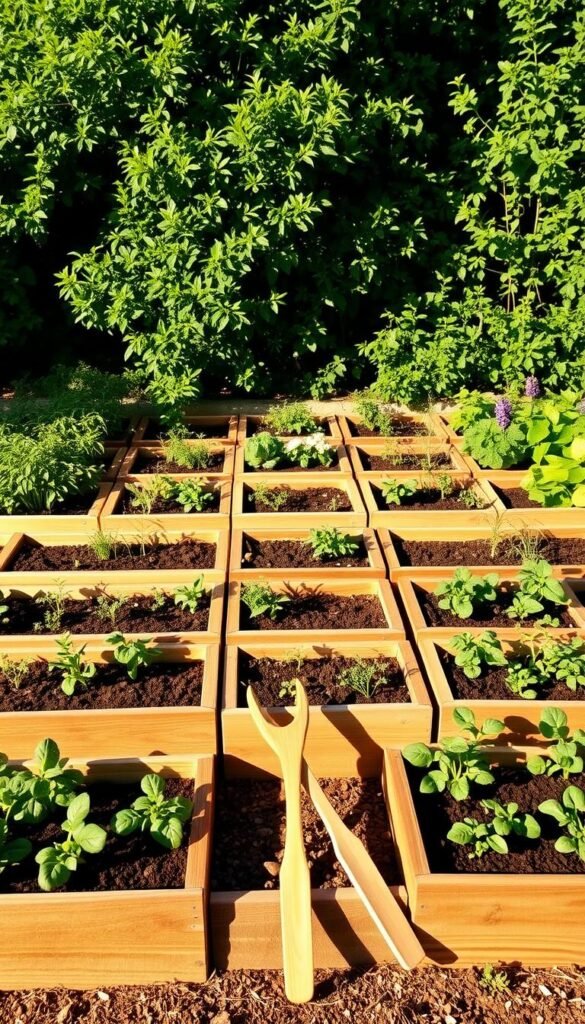
Smart layout design turns limited space into a powerhouse of fresh flavors. By arranging herbs strategically, you’ll boost growth while keeping maintenance simple. Let’s break down how to organize plants for maximum efficiency.
Optimizing Space and Planting Order
Start by mapping your garden grid. Place taller herbs like rosemary or dill on the north side to avoid shading smaller plants. Low-growing thyme and oregano thrive in southern sections where sunlight floods in. This order ensures every plant gets its daily light quota.
Group herbs with similar water needs together. Create a “thirsty zone” for basil and mint near your watering source, and a “dry area” for sage and lavender. Raised beds with dividers help maintain these micro-environments. You’ll waste less water and prevent root rot.
| Layout Feature | Traditional Rows | Square Foot Approach |
|---|---|---|
| Vertical Space | Rarely used | Trellises for climbers |
| Plant Height | Mixed randomly | Tall to short gradient |
| Access Paths | Wide between rows | Compact walkways |
Mark zones with colored stakes or labels. A “quick-pick” section near the front makes daily herb snips effortless. Leave 6-inch gaps between thyme clusters – they’ll spread faster than parsley or chives. Rotate crops yearly to keep soil nutrients balanced.
Your plants grow best when their roots aren’t competing. Use the square foot method’s spacing rules: 1 large herb per square, 4 medium ones like thyme, or 9 small annuals. This system turns cramped gardens into organized, high-yield spaces.
Companion Planting and Natural Pest Control in Your Herb Garden
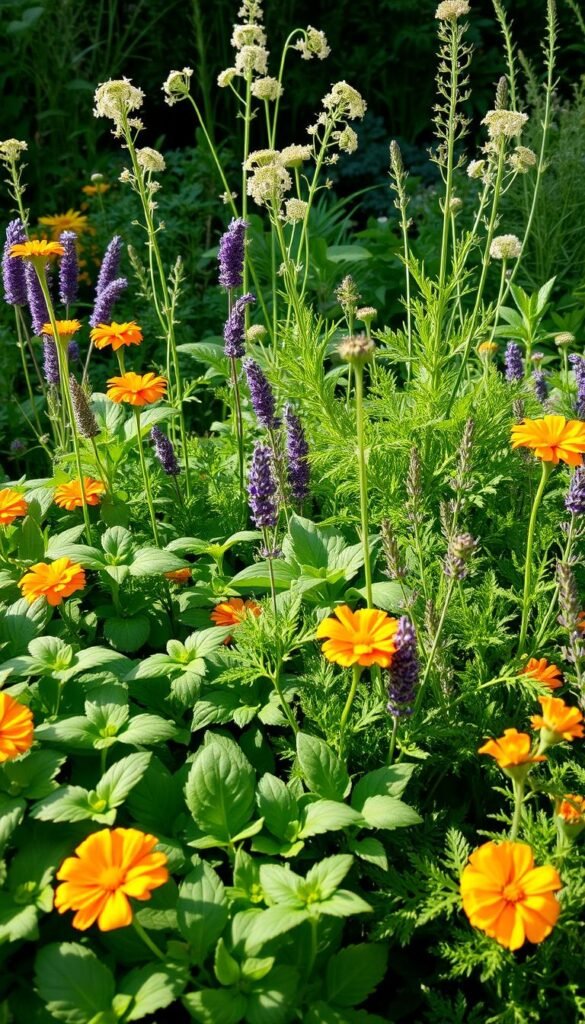
Discover how strategic herb pairings can defend your garden while boosting growth. Companion planting groups plants that benefit each other, cutting chemical use and creating a balanced ecosystem. By placing mint near cabbage-family crops, you’ll repel aphids naturally. Sage’s strong scent confuses pests like carrot flies, protecting neighboring vegetables.
Oregano acts as a living mulch, shading soil to retain moisture while deterring beetles. Pair it with basil and chives for triple protection – their oils disrupt pests’ navigation. This trio also shares similar sunlight needs, making watering efficient. Cluster these plants in sunny sections where their aromas mingle to confuse insects.
| Herb | Pest Repelled | Best Companions |
|---|---|---|
| Mint | Ants, cabbage moths | Broccoli, peas |
| Sage | Carrot flies, slugs | Rosemary, tomatoes |
| Oregano | Cucumber beetles | Peppers, squash |
Basil’s lush leaves shield soil from midday sun, helping moisture-loving chives thrive. Meanwhile, chives’ sulfur compounds prevent basil from developing fungal issues. Try interplanting these with marigolds – their roots release pest-blocking chemicals. Rotate pairings yearly to keep your garden resilient.
Experiment with combinations that suit your cooking and local pests. A sage-oregano corner protects Mediterranean herbs, while mint barriers guard against invaders. Your plants grow stronger when they’ve got friends watching their back!
Your Next Steps for a Thriving Herb Garden Journey
Your journey to a vibrant herb haven begins with simple steps. By combining smart layouts with resilient plants like thyme, oregano, and sage, you’ll create a space that thrives through shifting seasons. Remember: strategic companion pairings boost growth, while regular harvesting keeps flavors fresh and plants productive.
Start small by choosing three herbs that match your climate – perhaps mint for refreshing teas, parsley for kitchen staples, or chives for quick garnishes. These choices adapt well to containers or raised beds, letting you experiment without overwhelm. Rotate crops annually and adjust watering as temps change to maintain healthy roots.
Don’t forget lemon balm’s calming leaves or dill’s pest-repelling power – both thrive in partial shade and add unique benefits. As your herbs grow, expand your garden with new varieties that excite your family’s palate.
Grab your seeds today and transform that sunny corner into a flourishing patch. With each season, you’ll discover how thoughtful care turns limited space into an endless supply of homegrown goodness. Happy planting!

